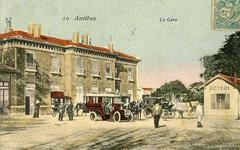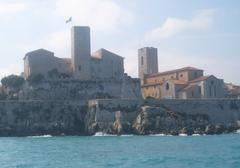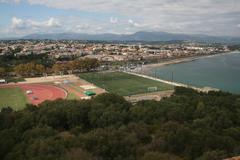
Château Salé Antibes: Complete Visiting Hours, Tickets, and Travel Guide
Date: 03/07/2025
Introduction: Why Visit Château Salé in Antibes?
Château Salé, nestled in the heart of Antibes on the sun-drenched French Riviera, is a landmark that encapsulates the region’s layered history, architectural grandeur, and vibrant cultural life. Known as the Salt Castle, this site has served as a strategic fortress, tax collector’s residence, prison, military barracks, and now as a museum—testament to Antibes’ ability to adapt through the centuries. Its story is interwoven with the legacies of the Grimaldi family, the era of the salt tax, the influence of Napoleon Bonaparte, and the artistic revolution initiated by Pablo Picasso’s residency. Today, Château Salé invites visitors to explore its imposing ramparts, historic chambers, and curated exhibitions, all while enjoying panoramic Mediterranean views.
For current visiting information, ticketing, and cultural events, consult the Musée Picasso website and the Antibes tourism office (French Lessons Blog, Kirstie Will Travel).
Contents
- Historical Overview: Origins to Modern Era
- Architecture: Medieval Foundations to Renaissance Splendor
- Château Salé Today: Museum and Cultural Venue
- Visitor Information: Hours, Tickets, and Tips
- Accessibility and Guided Tours
- Nearby Attractions
- FAQs
- Plan Your Visit: Practical Recommendations
- Sources
Historical Overview: Origins to Modern Era
Ancient Roots and Medieval Power
Château Salé’s history stretches back to the 5th century BCE, when Antibes (then Antipolis) was established as a Greek outpost (French Lessons Blog). The site evolved under Roman influence and, by the Middle Ages, became a focal point for regional defense and governance. Its seaside location made it a critical military stronghold, often contested by feudal lords, the Church, and foreign powers.
The Grimaldi Dynasty
In the late 14th century, the Grimaldi family—powerful Genoese nobles—secured their rule over Antibes and its castle, as documented in medieval parchments recently returned to France (French Lessons Blog). Marc and Luc de Grimaldi received the castle from Antipope Clement VII, solidifying their authority during a period of papal and political upheaval.
Royal and Revolutionary Eras
The castle passed to French royal control in 1608 under Henri IV, later serving as a royal governor’s residence, town hall, and military barracks. The name “Salé” references the gabelle, the royal salt tax administered from the château (nicematin.com). During the late 18th century, the Bonaparte family briefly resided here, and the château was used as a prison in the Napoleonic era (cityzeum.com).
20th Century: Preservation and Picasso
Purchased by the city in 1925, Château Salé became a museum, and after World War II, hosted Pablo Picasso as an artist-in-residence. His works are now a highlight of the Picasso Museum, ensuring the château’s continued cultural relevance (French Lessons Blog).
Architecture: Medieval Foundations to Renaissance Splendor
Defensive Origins
Constructed atop ancient fortifications, Château Salé features thick limestone and brick walls, battlements, and arrow slits—hallmarks of Provençal military architecture (kirstiewilltravel.com). Four distinctive round towers from the 16th century reinforced the castle’s defensive capabilities.
Renaissance and Later Adaptations
The château underwent significant Renaissance modifications: towers were reinforced for artillery, bastions added, and stone windows introduced for light and aesthetics. The juxtaposition of medieval masonry with Renaissance detailing defines its unique architectural character.
Interior Spaces
Inside, vaulted chambers, storerooms, and residential quarters surround a central courtyard. Decorative plasterwork, frescoes, and period fireplaces evoke the lives of its former inhabitants. Later centuries saw the addition of administrative offices and military installations.
Château Salé Today: Museum and Cultural Venue
Now home to the Musée Napoléonien, Château Salé displays artifacts related to Napoleon and local history (cityzeum.com). The Picasso Museum, housed in the adjacent Château Grimaldi, features works created during Picasso’s residency (See Antibes). Restoration efforts have preserved the site’s historical integrity while integrating modern amenities for visitors (nicematin.com).
Visitor Information: Hours, Tickets, and Tips
- Opening Days: Tuesday to Sunday (closed Mondays and select holidays)
- Hours: 10:00 AM – 6:00 PM (last admission 5:30 PM)
- Ticket Prices: Adults €7, reduced €4 (students/seniors), children under 12 free
- Where to Buy: On-site at the museum entrance or online via the Antibes tourism website
- Guided Tours: Weekends and by appointment; available in French, with English tours in high season
For the latest updates, always check the official Antibes tourism office before your visit.
Accessibility and Guided Tours
While museum spaces are wheelchair accessible, certain historic areas (towers, ramparts) may present challenges due to stairs and uneven flooring. It is recommended to contact the museum ahead of your visit to discuss accommodations. Guided tours provide in-depth historical and architectural context, with advance booking recommended, especially for English-language tours (Travel Pander).
Nearby Attractions
Enhance your visit by exploring:
- Picasso Museum (Château Grimaldi): Masterpieces from Picasso’s Antibes period (See Antibes)
- Fort Carré: 16th-century coastal fortress with panoramic sea views (pocketwanderings.com)
- Antibes Cathedral: Renowned for its historic façade and Louis Brea altarpiece (Travel France Blog)
- Marché Provençal & Port Vauban: Experience local culture and cuisine
FAQs
Q: What are Château Salé’s opening hours?
A: Tuesday to Sunday, 10:00 AM to 6:00 PM. Closed Mondays and select holidays.
Q: How much are tickets?
A: €7 for adults, €4 for students/seniors, children under 12 free.
Q: Is the château accessible for people with disabilities?
A: Main museum areas are accessible, but some historic areas are not. Contact the museum in advance for details.
Q: Are guided tours available?
A: Yes—weekends and by appointment. English tours are available in high season.
Q: Can I combine my visit with other Antibes sites?
A: Absolutely—Picasso Museum, Fort Carré, and the historic old town are all nearby.
Plan Your Visit: Practical Recommendations
- Arrival: The château is in Antibes’ old town; best reached on foot. Public transport and hop-on-hop-off buses stop nearby.
- Parking: Limited near the château; public lots available at Port Vauban.
- Best Time: Spring and fall offer pleasant weather and fewer crowds.
- Dress: Wear sturdy shoes for cobblestones and stairs; bring sun protection.
- Tickets: Book online during peak season to avoid queues.
- Photography: Permitted outdoors; ask about indoor restrictions.
- Family-friendly: Guided tours make history engaging for all ages.
- Dining: Explore nearby cafés and Provençal eateries after your visit.
Sources
- French Lessons Blog: Princes and an Antipope
- Kirstie Will Travel: Best Things to Do in Antibes
- CityZeum: Musée Napoléonien
- Nice Matin: Châteaux cachés à Antibes
- Cap Voyage: Patrimoine d’Antibes
- Tourist Places Guide: Antibes Attractions
- Pocket Wanderings: Things to Do in Antibes
- Travel France Blog: Best Things to Do in Antibes
- Travel Pander: Picasso Museum in France
- See Antibes: What’s On in July
For additional travel tips, detailed guides, and up-to-date cultural information, download the Audiala app and follow us on social media. Plan your immersive journey into Antibes’ rich heritage today!




